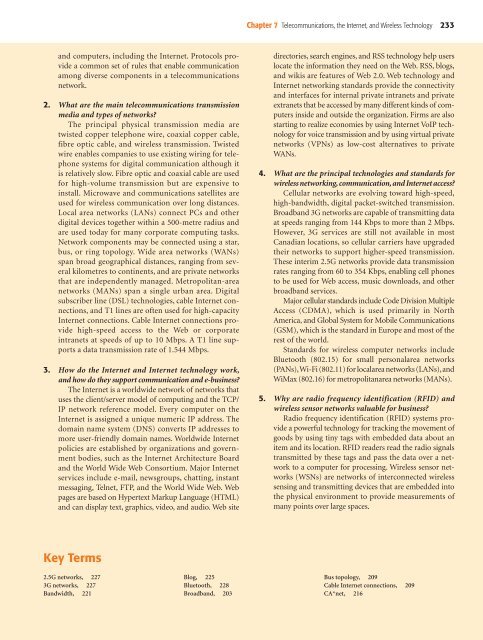Telecommunications, the Internet, and Wireless ... - Pearson Canada
Telecommunications, the Internet, and Wireless ... - Pearson Canada
Telecommunications, the Internet, and Wireless ... - Pearson Canada
You also want an ePaper? Increase the reach of your titles
YUMPU automatically turns print PDFs into web optimized ePapers that Google loves.
Chapter 7 <strong>Telecommunications</strong>, <strong>the</strong> <strong>Internet</strong>, <strong>and</strong> <strong>Wireless</strong> Technology 233<br />
<strong>and</strong> computers, including <strong>the</strong> <strong>Internet</strong>. Protocols provide<br />
a common set of rules that enable communication<br />
among diverse components in a telecommunications<br />
network.<br />
2. What are <strong>the</strong> main telecommunications transmission<br />
media <strong>and</strong> types of networks?<br />
The principal physical transmission media are<br />
twisted copper telephone wire, coaxial copper cable,<br />
fibre optic cable, <strong>and</strong> wireless transmission. Twisted<br />
wire enables companies to use existing wiring for telephone<br />
systems for digital communication although it<br />
is relatively slow. Fibre optic <strong>and</strong> coaxial cable are used<br />
for high-volume transmission but are expensive to<br />
install. Microwave <strong>and</strong> communications satellites are<br />
used for wireless communication over long distances.<br />
Local area networks (LANs) connect PCs <strong>and</strong> o<strong>the</strong>r<br />
digital devices toge<strong>the</strong>r within a 500-metre radius <strong>and</strong><br />
are used today for many corporate computing tasks.<br />
Network components may be connected using a star,<br />
bus, or ring topology. Wide area networks (WANs)<br />
span broad geographical distances, ranging from several<br />
kilometres to continents, <strong>and</strong> are private networks<br />
that are independently managed. Metropolitan-area<br />
networks (MANs) span a single urban area. Digital<br />
subscriber line (DSL) technologies, cable <strong>Internet</strong> connections,<br />
<strong>and</strong> T1 lines are often used for high-capacity<br />
<strong>Internet</strong> connections. Cable <strong>Internet</strong> connections provide<br />
high-speed access to <strong>the</strong> Web or corporate<br />
intranets at speeds of up to 10 Mbps. A T1 line supports<br />
a data transmission rate of 1.544 Mbps.<br />
3. How do <strong>the</strong> <strong>Internet</strong> <strong>and</strong> <strong>Internet</strong> technology work,<br />
<strong>and</strong> how do <strong>the</strong>y support communication <strong>and</strong> e-business?<br />
The <strong>Internet</strong> is a worldwide network of networks that<br />
uses <strong>the</strong> client/ server model of computing <strong>and</strong> <strong>the</strong> TCP/<br />
IP network reference model. Every computer on <strong>the</strong><br />
<strong>Internet</strong> is assigned a unique numeric IP address. The<br />
domain name system (DNS) converts IP addresses to<br />
more user-friendly domain names. Worldwide <strong>Internet</strong><br />
policies are established by organizations <strong>and</strong> government<br />
bodies, such as <strong>the</strong> <strong>Internet</strong> Architecture Board<br />
<strong>and</strong> <strong>the</strong> World Wide Web Consortium. Major <strong>Internet</strong><br />
services include e-mail, newsgroups, chatting, instant<br />
messaging, Telnet, FTP, <strong>and</strong> <strong>the</strong> World Wide Web. Web<br />
pages are based on Hypertext Markup Language (HTML)<br />
<strong>and</strong> can display text, graphics, video, <strong>and</strong> audio. Web site<br />
directories, search engines, <strong>and</strong> RSS technology help users<br />
locate <strong>the</strong> information <strong>the</strong>y need on <strong>the</strong> Web. RSS, blogs,<br />
<strong>and</strong> wikis are features of Web 2.0. Web technology <strong>and</strong><br />
<strong>Internet</strong> networking st<strong>and</strong>ards provide <strong>the</strong> connectivity<br />
<strong>and</strong> interfaces for internal private intranets <strong>and</strong> private<br />
extranets that be accessed by many different kinds of computers<br />
inside <strong>and</strong> outside <strong>the</strong> organization. Firms are also<br />
starting to realize economies by using <strong>Internet</strong> VoIP technology<br />
for voice transmission <strong>and</strong> by using virtual private<br />
networks (VPNs) as low-cost alternatives to private<br />
WANs.<br />
4. What are <strong>the</strong> principal technologies <strong>and</strong> st<strong>and</strong>ards for<br />
wireless networking, communication, <strong>and</strong> <strong>Internet</strong> access?<br />
Cellular networks are evolving toward high-speed,<br />
high-b<strong>and</strong>width, digital packet-switched transmission.<br />
Broadb<strong>and</strong> 3G networks are capable of transmitting data<br />
at speeds ranging from 144 Kbps to more than 2 Mbps.<br />
However, 3G services are still not available in most<br />
Canadian locations, so cellular carriers have upgraded<br />
<strong>the</strong>ir networks to support higher-speed transmission.<br />
These interim 2.5G networks provide data transmission<br />
rates ranging from 60 to 354 Kbps, enabling cell phones<br />
to be used for Web access, music downloads, <strong>and</strong> o<strong>the</strong>r<br />
broadb<strong>and</strong> services.<br />
Major cellular st<strong>and</strong>ards include Code Division Multiple<br />
Access (CDMA), which is used primarily in North<br />
America, <strong>and</strong> Global System for Mobile Communications<br />
(GSM), which is <strong>the</strong> st<strong>and</strong>ard in Europe <strong>and</strong> most of <strong>the</strong><br />
rest of <strong>the</strong> world.<br />
St<strong>and</strong>ards for wireless computer networks include<br />
Bluetooth (802.15) for small personalarea networks<br />
(PANs),Wi-Fi (802.11) for localarea networks (LANs),<strong>and</strong><br />
WiMax (802.16) for metropolitanarea networks (MANs).<br />
5. Why are radio frequency identification (RFID) <strong>and</strong><br />
wireless sensor networks valuable for business?<br />
Radio frequency identification (RFID) systems provide<br />
a powerful technology for tracking <strong>the</strong> movement of<br />
goods by using tiny tags with embedded data about an<br />
item <strong>and</strong> its location. RFID readers read <strong>the</strong> radio signals<br />
transmitted by <strong>the</strong>se tags <strong>and</strong> pass <strong>the</strong> data over a network<br />
to a computer for processing. <strong>Wireless</strong> sensor networks<br />
(WSNs) are networks of interconnected wireless<br />
sensing <strong>and</strong> transmitting devices that are embedded into<br />
<strong>the</strong> physical environment to provide measurements of<br />
many points over large spaces.<br />
Key Terms<br />
2.5G networks, 227<br />
3G networks, 227<br />
B<strong>and</strong>width, 221<br />
Blog, 225<br />
Bluetooth, 228<br />
Broadb<strong>and</strong>, 203<br />
Bus topology, 209<br />
Cable <strong>Internet</strong> connections, 209<br />
CA*net, 216
















